I’ve fallen in love with gardening all over again.
As many of you know, 2014 was the first year I ventured into the world of deep mulch gardening.
Considering it’s October, I figured it was time to take final inventory of my experience and type out my thoughts and revelations (mostly because I know I’ll forget come next year…)
To sum it up?
Deep mulch gardening is the best thing that’s ever happened to my garden.
Period.
I LOVE IT. I will NEVER go back to bare dirt gardening. Never, ever, ever.
To read a little background on this my crazy mulching adventure and to learn more of the specifics of this whole deep mulch thang, check out this post where I talk about mulching for the first time, and then this post where I give a mid-summer mulching update.
For those of you who are curious about my final yields and such, here are all the nitty-gritty details—>
**IMPORTANT: If you are planning on using deep mulch, please make sure you are ONLY using hay or straw that has NOT been sprayed with herbicides of any kind! Read my sad story about herbicide contamination here.**
2014 Yields from My Deep Mulch Garden
Keep in mind, I have a rather small garden plot. We have plans to expand, but have to build a literal fortress around anything we try to grow (because of wild critters and our barnyard critters), so while putting in a second plot is on the “list,” it hasn’t happened quite yet! However, I had impressive yields, even from my small plot!
Onions
By far, this was the best onion year I’ve ever had. I planted two long rows of purple onion sets and one row of sweet yellow onions. The were SO happy and grew like crazy. My yellow onions were HUGE and just as pretty as the ones you can find at the store.
Now comes the sad part of the story… Our lovely turkey apparently has an affinity for onions, and wiped out nearly the entire harvest before I realized what had happened. So, I ended up with just one measly onion braid. However, that wasn’t the deep mulch’s fault, and next year I know to be extra-careful to leave the garden gate SHUT!
Peas & Beans
These were one of the few things I actually struggled a bit with this year. However, I don’t think the deep mulch is to blame. The early part of summer was very cool, and the pea & bean seeds really struggled to germinate. I replanted several times, but never ended up with a great yield. However, I still was able to harvest 3-4 gallon baggies of yellow beans to store in the freezer, so that’ll keep us in beans for a while, at least.
Beets and Kohlrabi
The beets were out of control this year! I ended up canning several batches and still have a bag in the fridge to eat! I mostly planted the white albino beets from Baker Creek Heirloom Seeds, but also did half a row of regular red beets. This was my first year of growing kohlrabi, so I just planted one row. However, it thrived in the deep mulch and we had more kohlrabi than we could eat.
Pumpkins
This was an interesting experiment, since I decided to plant my pumpkin seeds in my failed hugulkultur bed from last year. I didn’t have high hopes, but poked a handful of seeds into the bed anyway and covered them in deep hay mulch as the plants popped through the compost. Much to my surprise, the pumpkins flourished and we ended up with 10-12 gorgeous Winter Luxury pumpkins from just a handful of seeds. I even had enough pumpkins to preserve for later, and I was able to enjoy my first pumpkin canning experience!
Potatoes
As I mentioned in my mid-summer mulching update post, my potatoes had a bit of a rocky start. Apparently, I covered them with too much mulch, and the shoots had a hard time poking through the thick layer of hay. Once I realized my mistake and removed a bit of the bulk, the green plants happily popped up and grew wildly. (Thankfully, potatoes are very forgiving, even after you try to smother them…)
In the past I’ve planted potatoes the traditional way: digging a deep trench, laying the seed potatoes in the trench, and then mounding more and more dirt as the potatoes sprouted. However, I decided to be a bit rebellious this year… I laid the seed potatoes on the dirt, but rather than mounding them up, I simply covered them with hay. I was holding my breath when I harvested them last month, half-expecting to be completely potato-less. But, the mulch came through for me again! I ended up with heaping boxes of gorgeous Yukon gold potatoes from just 3 rows. And the best part? I didn’t have to mess with mounding them this summer, and harvest was super easy– just pull back the hay and grab the spuds!
Tomatoes
In the past, tomatoes have been my nemesis… I’ve had a few years where the plants seemed happy, but ended up producing dismal yields. I planted 8-10 tomato plants this year (mostly romas and Amish Paste tomatoes for making sauce) and surrounded the seedlings with hay mulch. Those few plants gave us boxes and boxes of tomatoes! Our crazy-early freeze forced me to harvest many of them green and ripen them in boxes, but regardless, I had enough homegrown tomatoes to make a full batch of sauce. This is a first for me!
Cabbage, Carrots, and Squash
I planted a few cabbage seedlings this year and they were downright picturesque growing happily in their mulch.
The carrots grew happily, although I did have some deformed ones. I’ve since been informed (by smarter gardeners than me) to amend the bed next year with kelp meal or wood ash to prevent the, er, unique formations. I think I also need to work the soil in my carrot rows a bit deeper.
As usual, I planted my squash too close together, so my zucchini and spaghetti squash had babies… Regardless, we enjoyed ample amounts of chocolate zucchini bread, and have several spaghetti squashes stored away for winter.
The Watering
Wyoming can be desperately dry in the summers. In previous years, I would often water every single day, and my garden would still wilt and dry out. It was… annoying. And frustrating.
With my deep mulch, this year I only watered about twice per week. The hay kept the underlying soil moist and soft, even when everything else outside was blazing hot. This saved me a lot of time dragging hoses around AND seriously cut down on our water usage.
The Weeding
I know everyone has weeds, but in year’s past, we had weeds in epic proportions. My poor baby seedlings usually didn’t even get a chance to germinate before they were already getting choked out. It was vicious.
I would spend hours and hours each week weeding like crazy, but could NEVER get ahead of them. As a mom, a homesteader with lots of other projects, and a business owner, I couldn’t afford to spend that much time in the garden, and was seriously considering giving up gardening entirely. (Ask my husband–I’m not kidding!) I wasn’t enjoying it, and had a pit in my stomach every time I’d go out to check on the veggies.
Deep mulch made me fall in love with gardening all over again.
This year? I spent about 10-15 minutes every other day checking on the rows and pulling a few weeds here and there. Sometimes I’d add an extra handful of hay if a spot was becoming bare, or pull a bit of hay back if it had scooted too close to the seedlings. But that’s it. For real.
And as payment for my minimal time spent in the garden? I was rewarded with the most bountiful harvest I’ve ever experienced.
G’night Garden
Our gardening season is complete and everything has been harvested. I left many of plant remnants in place and covered the entire garden plot with a generous blanket of hay for the winter. The plan is for the plant matter and hay to begin decomposing to create a whole new layer of nutritious-goodness for next year.
Come spring, I’ll pull the hay back from where I plan to place my rows to allow the soil to warm up, and we’ll start the process all over again. And for the first time ever? I’m actually looking forward to gardening season.
Where I Got My Crazy Ideas
This book by Ruth Stout (affiliate link) was the #1 driving force in my decision to use deep hay mulch this year. She was quite revolutionary in her time, and I followed many of her sassy suggestions to the letter. As crazy as many of her suggestions sounded at first, they haven’t failed me yet!
Other Gardening Goodies You Might Enjoy:
- I get all my heirloom seeds from Baker Creek
- How to Prep Your Garden for Winter
- My introductory Deep Mulch post (explains the process)
- 2014 mid-summer Deep Mulch update
What types of mulch have you used in your garden? Any stories to share?

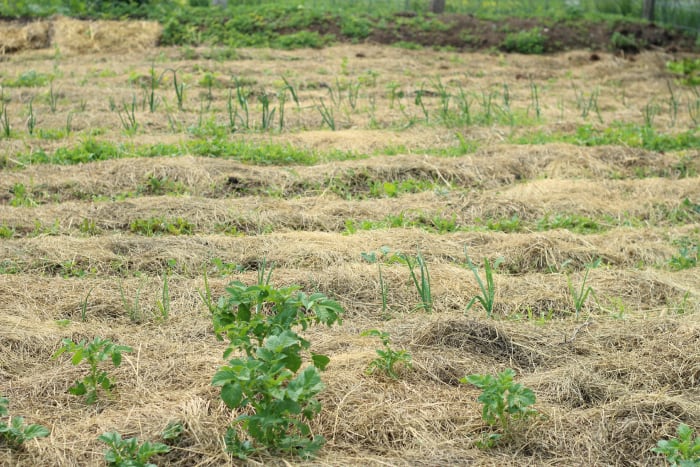
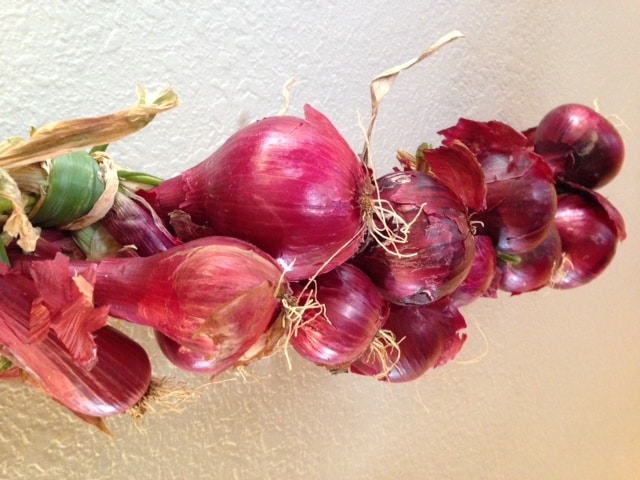

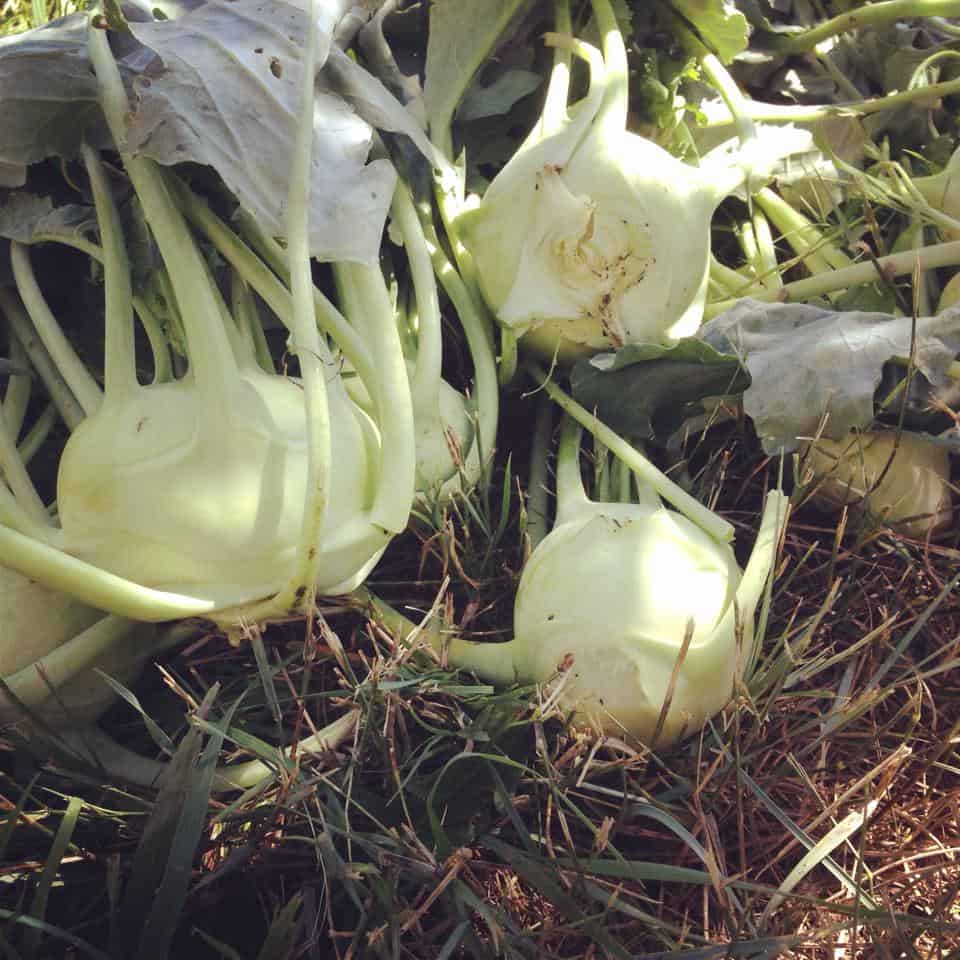
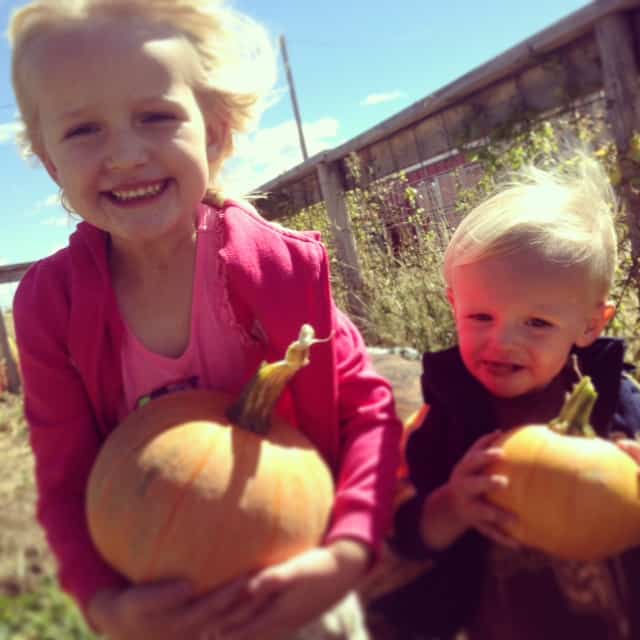
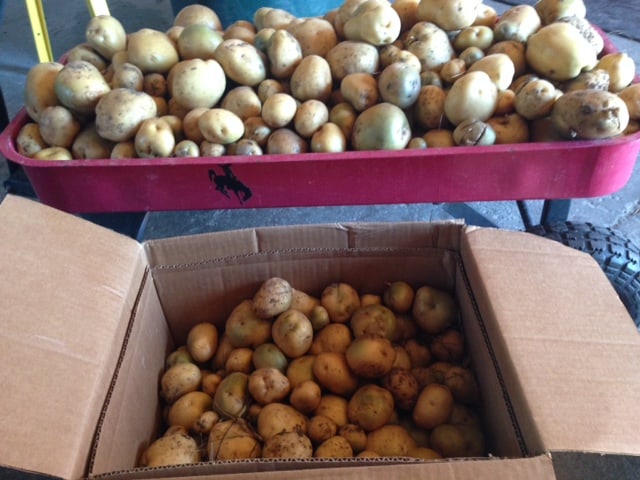
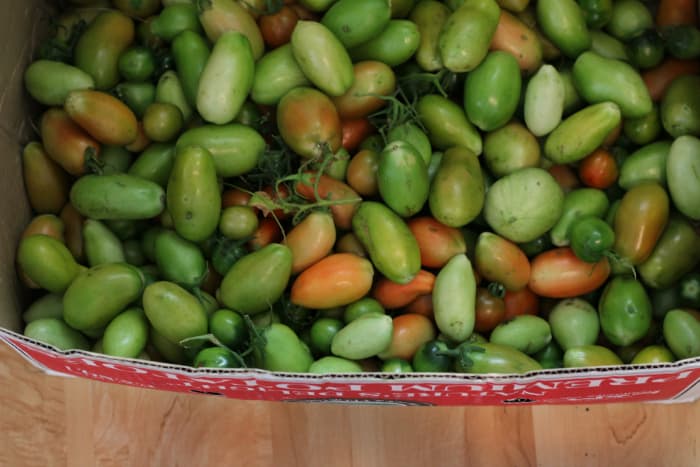
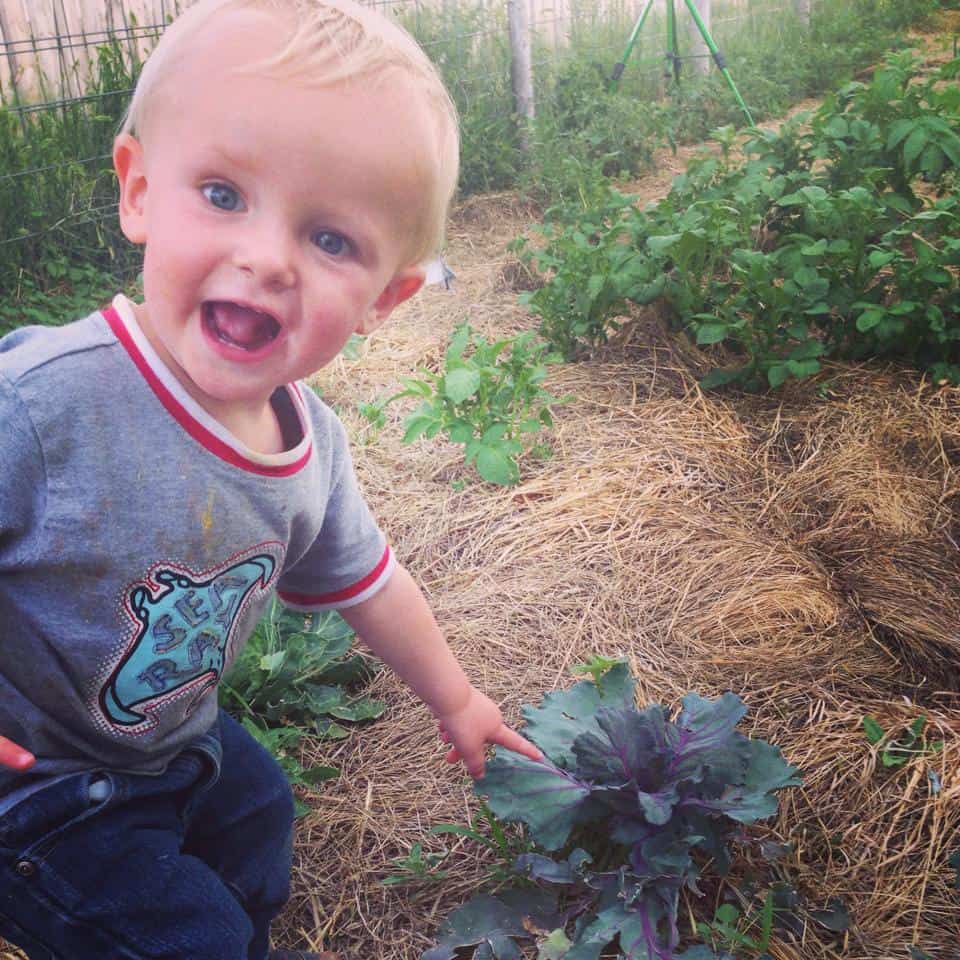

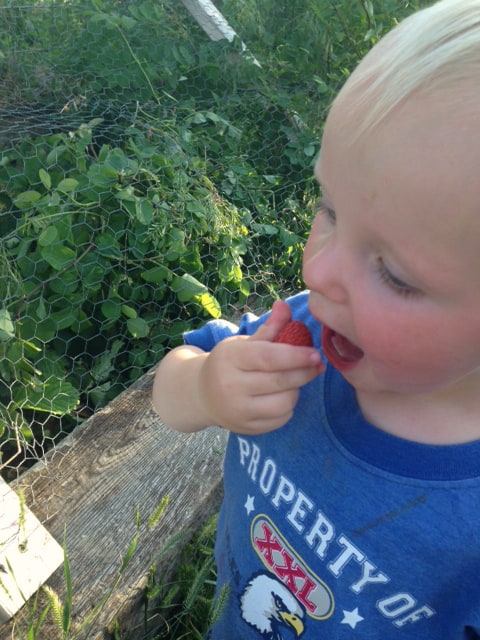
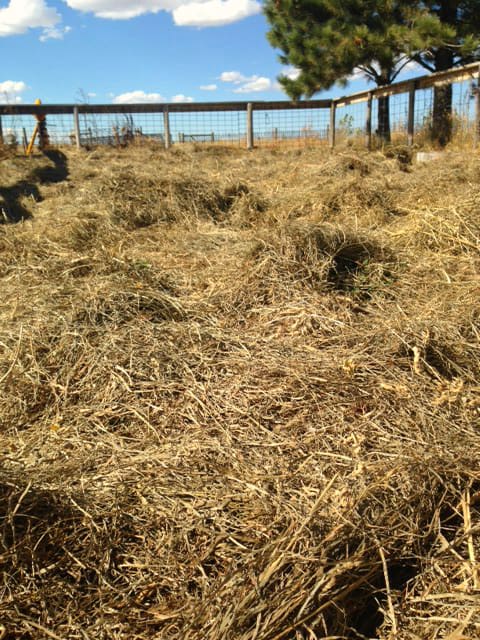

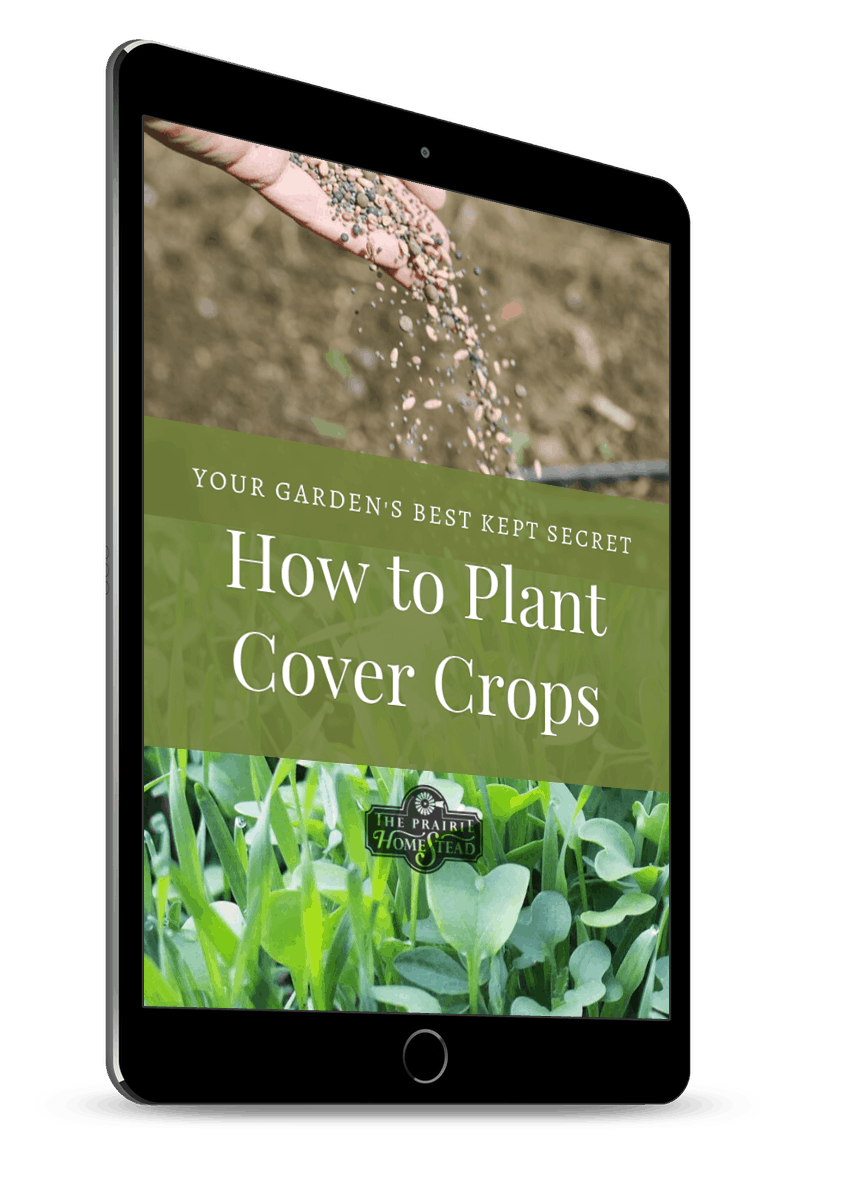

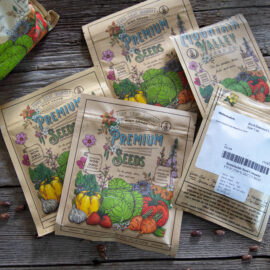
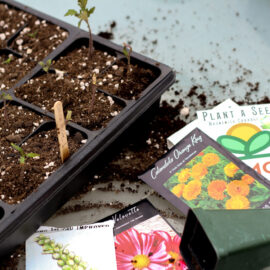
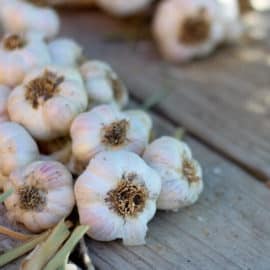
I have been watching your progress all summer long and I am amazed at how well it did for you! We always cover our garden with a 6mil black plastic when it is all done for the year and it seems to help cut down on the weeds the following year. However, after following you all summer I may just try deep mulching next year! Thanks for sharing this tip with us!
I think you’ll really enjoy it Tracy! Very satisfying. 🙂
and the nice thing about mulch is it creates compost right on top of your garden where you want it!
Have you thought about letting your chickens range in the mulched garden now that it has been retired until Spring? They could eat the old seeds & bugs, and leave you extra fertilizer in return.
Yes, I plan to leave the gate open so they can rummage around in there! 🙂
Wow, I want to try this next year too! We have johnson grass, which is the absolute devil. We tried putting our hogs in the garden, and rotating the, but the johnson grass still came back. Anyway, this looks great–and I get our seeds from Baker’s too–love them!
I have been following you all summer and am so happy it was a good experience for you! I have some junk hay that we plan to spread on our garden this weekend; I hope our results are as good as yours were. Do you still plan to use this same method next year? Are you still considering trying woodchips? I’m still very new to this homesteading thing and have a black thumb (lucky for me my husband is a great gardener). Thank you for sharing your knowledge!
Yes– we’ll definitely be doing this method again next year! No plans for woodchips, yet– still having too much fun with the hay!
Wow, this was a great read. We tried the exact same thing this year! We have 2 garden plots and completely mulched the one with old hay and left the other to grow the conventional way. As soon as it got a tiny bit warm the plot without mulch quickly grew a grass mat.. it was soo much work and effort to weed! The veggies in that plot did very poorly(tomatoes, onions, lettuce, watermelons) but the veggies in the mulched plot did wonderfully- (Corn, potatoes, spinach, cherry tomatoes, green beans, peas, cabbage, zucchini) all except for the pumpkins and cantalope we tried to grow. We can’t figure if we smothered them or didn’t water them enough, since they need so much more water than other veggies. The only things that had trouble germinating in our mulched bed were the carrots and beets.. we completely covered them instead of pulling the hay back in rows to plant them and I don’t think they got enough sun. The potatoes we covered with hay after they sprouted. And we got a very early freeze here as well (Potter County PA) so I had to box ripen alot of green tomatoes too to get as much sauce as I wanted. How do you store your carrots and potatoes over the winter? This was our first year growing potatoes, but last year I canned my carrots. This year we are trying storing them in half barrels (55 gal plastic) in layers with dirt. It’s nice to know we aren’t the only crazy ones out there! haha 🙂
HA! You’re definitely not the only crazy ones! 🙂 Happy to hear you had success too!
P.S. I LOVE the pic of your little guy with his huge grin 🙂
I love this too! My big question though, is how do you keep your chickens and turkeys out of the garden? I am assuming you free-range, but it kept me from gardening this year, because they simply flew over the fence. I would love to hear your thoughts…
Our fence is fairly tall, so they haven’t flown over–yet!
Has anyone tried this in the PNW though. I once tried mulching just my potatoes with straw and the slugs were horrendous. I would suspect I would have the same problem with other crops.
Sara, check out Back to Eden movie. Paul Gautschi lives in PNW (as do I) and the wood chips are great for areas of too much (and too little) moisture because they absorb and release it.
My son got me one of Ruth’s books for Christmas so this is exciting to see your results. I am ‘out of love’ with gardening this year, but am looking forward to better success. I have also been inspired by the Back to Eden movie and Paul Gautschi’s wood chip mulch success.
Hi Jill, have loved hearing about the deep mulching. I have a question though. With your wicked winds in Wyoming, how did you keep the hay in place? We live out on the plains in Colorado and would like to do the deep mulching also, but have not tried yet because I figured the neighbor would just have the hay in their yard when the wind started blowing. Thanks.
This is my question, too! We have a wicked wind problem. We put our hay/bunny bedding on the garden last year, and it blew up against the fence instead of staying put. What a mess! At least the wood chips stayed in place, so I buried the next batch of hay under the wood chips. Still, our garden was horrible this year. 🙁
We live in one of the windiest places in the US, but I really didn’t have much issue with wind. And we don’t have a windbreak on that side of the garden either. After a big thunderstorm, etc, sometimes the rows would need a bit of adjusting, but that’s it! The hay settled pretty quickly and “matted” down.
I am curious about the straw you used. I have attempted twice to use straw and both times it ended up sprouting in my garden. Even when I bought certified seed free.
I actually didn’t use much straw– mostly old hay.
I was wondering, do you think I could use wood shavings, like the ones from the chicken coop for the deep mulch method?
Yes, wood shavings should work too! Just make sure if there is manure too, it’s old–otherwise it might get too “hot”
we also use a version of this method! i just wanted to clarify something though… did you actually use hay? or did you use straw? it is an important difference. hay has grass seed… straw has no seed in it. we use straw and have been happy with the results, too!
We used hay. 🙂 Although I did put a small amount of straw on my pumpkins/strawberries.
Jill, after going back and reading your mid summer post and original post more thoroughly I realize I am just another pest, re: BTE.
One thing about it is: you don’t use just “wood chips” = pure carbon, the wood chips used are green, leafy branches that have been trimmed and chipped and have an ideal balance of carbon / nitrogen, brown / green, for composting.
Paul’s garden is not an “anomaly” although his method may not work for everyone, there are many, many happy BTE gardeners around. (There is a Facebook group).
HTH anyone interested, but from what I have read here, and in Ruth’s book, and elsewhere, the deep hay mulch actually makes more sense to me too.
You’re not a pest Cecila. 😉 Yes, I know some folks have had success with BTE, but with our climate here in WY, it was just making me nervous. However, I still might do a test plot in the future!
I live in N. Idaho, on the dry side of the Rockies, we have a short, hot, dry summer, and Horrible Clay soil. I have been ‘fighting’ to grow a garden for Years. We have chipped up a bunch of our own tree trimmings this fall and I am hoping to get a load of chips. I will let you know how it works for me in my similar climate. (P.S. our family loooves WY, we drive through on the way to “Grandma’s House” back east)
Hi Cecilia. It is my understanding that it is perfectly okay to mulch with the wood chips, you just don’t want to mix the fresh chips into the soil where the roots are. That is where the problem with nitrogen kicks in. We mulched areas of our daughter’s community garden last year with shredded Cyprus mulch and it was totally degraded by the end of growing season with no ill effects. Here in WI, we have a lot of mature shrubs and trees that get serious haircuts every year. That all gets chipped up and thrown into the leaf and grass clippings and piled into our raised garden beds (we also have clay soil). I transplant my veggies into this raw mix by digging a “perimeter hole” that is filled with a topsoil mix around the plants. That buffer zone seems to work. By the time the roots get to the raw stuff, they are ready for it. I pulled a tomato plant out of a raised bed last year that had a root system that ran about 5 feet laterally across the pile of new chipped leaves, grass and branches on top of the clay soil underneath. The plant was healthy and productive. You can stick squash, melons and cucumbers directly into the new mix of leaves, grass and wood chips then stand back and wait with your bushel baskets. BTW, I do also mulch over the top of this with clean straw hay.
Does anyone think leaves would work? If so , would they have to be chopped up?
Yep! I don’t think it’d be necessary to chop them up. 🙂
Love your blog and following along this summer to compare results. We purchased a small farm last year and I found one of Ruth’s books in the barn. This spring, we staked out 2 garden spots, one for a bed of asparagus and one for all the other veggies. I had always done traditional gardening but opted for deep mulch. Oh, my, what a difference it makes! I’ve canned, dried, frozen and put things in root cellar. We used mostly hay & straw but also collected coffee grounds from Starbucks whenever going into town.
The biggest issues we had were slugs, squash bugs and moles. The moles ate about 2/3s of the potatoes so we need to come up with a different plan for them next year. The slugs ruined a lot of tomatoes and peppers. The weather was so wet, I couldn’t keep the beer in the saucers but it worked when we would have a few dry days.
Next year, I plan to add wood chips and leaves. We purchased our chipper but due to hubby’s 2 surgeries, it never got setup. Plan is to use cedar chips on walkways and around the gardens. They supposedly keep bugs away and are very slow to break down. There’s a great website from the mid-west that uses raised rows and deep mulch. They have some great articles on how to get started, etc. http://oldworldgardenfarms.com/raised-row-gardening/
Hmmm… sorry to hear about your critter problems! We don’t have a lot of slugs/moles here, so it hasn’t been a problem for us–YET. 😉 I think the raised row idea sounds interesting!
Do you have any mice problems with this method? And do you have walkways between rows, do you have to worry about soil compression? Thanks!
No mice problems this year! There are walkways between the roads, but I haven’t really noticed a whole lot of compression.
I am already thinking about the garden we’ll have next spring. You had fantastic results with this!
I think you’ll enjoy this Leibfred!
I’m trying a mini version of this for the first time. It’s my hope with all of the scraps from garden leftovers, vines, leaves, grass trimmings, chicken poop & pine shavings, manure, and anything else I can throw in it will simmer through the winter once the snow has fallen. Luckily I have cats that love hanging out with the chickens and are great mousers! Good luck to everyone trying this method. I have no clue if it’s going to turn out. Will report back in the Spring.
Can’t wait to hear how it works for your Cynthia!!
How does the straw effect the carbon/nitrogen ratios in the soil? It’s my understanding that excess carbon (wood chips, dried grass, etc.) will “lock up” the nitrogen in the soil and negatively affect nutrient balance. Has anyone experienced this?
Yes, that is something I’ve heard as well– the difference here is that we aren’t tilling into the soil, only laying it on top.
I read Ruth Stout’s book some years ago. I’ve chuckled as “new” worded methods have popped-up over the years and others have tried to clam they were the pioneers for the mulch method. Even the EPA embraced her method to stabilize disturbed soil. In side areas, fence lines and walking paths you can lay in deep with wood chips. These will take about 3 years to compost down, will help to fight off weeds and loosen up old one’s. Good sources are tree trimmers that need a dumping site. Your so correct about “No Till” – “Top Soil” is one of our most vital resources. I truly believe that when we bless the earth the earth blesses us back.
I’ve enjoyed your article and the comments from readers. I, too, have a concern about mice building nests in the hay/straw. Mice just really give me the creeps! haha! So I think I may have to get some kittens. This spring I put some straw around the few broccoli plants I had and ended up with a rabbit’s nest under the straw into the roots of the plant. It didn’t seem to hurt the plant but momma rabbit had a salad bar everyday! My husband insists that I shouldn’t use hay because of the high weed seed content. Have you (or anyone else reading this) used both straw and hay and compared one versus the other?
I use rice straw as mulch. I also use the bales to create beds for my potatoes and other root vegetables to stop gophers from dining on them. I line the bottom of my “bale” gardens with hardware cloth. The bale gardens last two years. By the time I need new bales, the old bales have started to decomposed from the two seasons of winter rains (I live in Northern California) and are recycled as mulch. Works like a charm!
Love this post! We are in the process of buying our first farm and I’m looking forward to trying this. I do have a question though- do you have trouble with Bermuda grass with this method? I put a whole bale of hay on my garden last year and the Bermuda grass (a Oklahoma gardeners worst enemy!) wasn’t intimidated at all by it! It grew right up through the hay and in from the sides like it wasn’t even there. Do you have any suggestions? Thanks!
*a whole round bale not a small square bale